Brand awareness: What it is and strategies to improve it
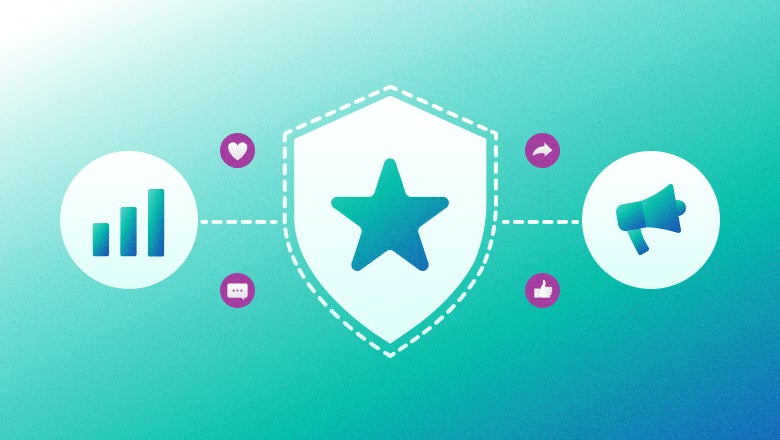
Table of Contents
What does it take to build brand awareness?
In the old days, a steady drumbeat of messaging across a few audience-preferred channels might’ve done the trick. But in today’s scattered, digital landscape, that messaging needs to be even more consistent—and more compelling—to get noticed.
While it takes effort, the payoff is substantial. High brand awareness, combined with strong reputation management, builds trust that fosters long-term customer relationships.
Building a memorable brand image takes some big swings, but you have to walk before you can run. To help, we’re breaking down the why and how behind driving and measuring brand awareness.
What is brand awareness?
Brand awareness is the extent to which audiences are familiar with your brand’s identity and its products or services. It’s the bedrock of your sales funnel. After all, you need to be able to recognize a brand to trust and buy from it.
Strong brand awareness is the competitive edge that keeps a business top-of-mind for consumers. Brands with high levels of consumer recognition can even become synonymous with their product. For example, when someone needs to fix a misspelled word written in pen, they’re usually not asking for “correction fluid”; they’re asking for Wite-Out.
Of course, achieving that level of brand recognition is a lofty goal. Our advice? Start where you are. Focus on building awareness within targeted audiences and grow from there.
Why is brand awareness important?
Brand awareness is crucial for building a strong market presence. When done well, it creates consumer trust and brand recognition that puts you top-of-mind when consumers are researching the products you offer.
Your brand awareness strategy will set the tone for a person’s entire experience with your brand. Start things out on the right foot, and you could sow the seeds for your next crop of brand advocates.
It’s more important than ever given artificial intelligence’s (AI) impact on how we discover products and information. The long-term impact of AI search is still uncertain, but more people are using AI tools to both find and choose between products and services.
A modern brand awareness strategy keeps your brand visible, even through shifting markets and digital environments. An effective strategy:
- Increases discoverability: Brand awareness campaigns help position your brand and get it in front of the people looking for your products or services.
- Sets the tone: A brand awareness strategy helps unify your brand’s messaging across multiple channels. This unification then allows your brand to resonate more strongly with your audience.
- Creates future brand advocates: Combine positive brand sentiment with high brand recognition and you get fans. If you support them, these fans can become brand advocates who are more likely to recommend your brand in their own personal networks.
- Develops brand trust: Over time, the more people see your brand, valuable messages and content, the more they trust you. This can create positive brand sentiment and a good reputation for your company, which leads to consumers keeping you top of mind when it’s time to buy.
What shapes a brand awareness strategy?
At its core, brand awareness is about standing out in a crowded market through consistent, memorable messaging and a strong visual identity. This can be achieved through a mix of:
- Organic social media
- Paid social media
- Content marketing
- PR
- Influencer marketing partnerships
All of the above are components of a broader social media amplification plan. The Sprout Social Index™ 2025 found that consumers now use social media more than anything else to keep up with trends and social moments (90%), which is why it’s the perfect place to build your brand awareness campaigns.
Brand awareness is the cornerstone of how consumers perceive and remember your brand. It works by increasing visibility across various touchpoints, making it easier for potential customers to recall your brand when they’re ready to make a purchase.
In the age of AI, this work is more important than ever. AI search results are shown based on trust and authority, and Large Language Models (LLMs) gather information from a huge number of sources when providing results, including social media, reviews, forums and more. Brands that are discussed positively in these spaces are more likely to be seen as trusted authorities, making them more likely to appear during AI searches.
At the end of the day, long-term brand awareness hinges on resonance—the ability of your audience to not only remember your ad but also like it, associate it with your brand and ultimately consider your brand when making purchasing decisions. This resonance keeps your brand top-of-mind, shortening sales cycles, reducing customer acquisition costs and fostering long-term loyalty.
How to measure brand awareness
Measuring brand awareness involves tracking metrics that show how many people know and talk about your brand.
Connecting brand awareness to ROI can feel like trying to explain how to get from Chicago to San Francisco by foot. Sure, it’s doable, but it’s pretty complicated.
The classic marketing funnel looks straightforward, but in reality, every customer journey is different and some can be much longer than others. Trying to track and assign value to every interaction between awareness and purchase simply isn’t the best use of anyone’s time.
Although it may be difficult to quantify the monetary value of every awareness effort, there are still important metrics worth tracking. There are quite a few methods to understand your efforts as you pilot new awareness strategies. Here are some of our favorites to help you measure brand awareness.
Brand surveys
Brand surveys are routine (often biannual) surveys that assess what an audience thinks and feels about your brand. Data from brand surveys can be used to track brand perception over time, providing businesses with the insights needed to shape their brand’s image in the right direction.
Unfortunately, these surveys take weeks (if not months) to design and distribute. If you want more timely data, you’ll want to supplement a brand survey with the following options.
Website traffic
Tracking month-over-month differences in web traffic isn’t an exact measurement of brand awareness. However, it’s much easier to connect web traffic to ROI, making it a management-preferred reporting metric.
As you test out new brand awareness tactics, use Google Analytics to see how those changes impact growth in new users. That’ll give you a rough estimate of how your efforts translated to site traffic. Take advantage of Google Search Console’s “search results” report. Filter this to your brand name to better understand both the reach of your brand and the type of searches usually associated with it.
You can also dig deeper to look at specific traffic sources, like organic search, referral and direct traffic. Direct traffic means someone found your site through a firsthand channel–like typing your brand’s URL into the address bar or revisiting a bookmarked page–a good indicator of brand awareness.
Social Listening
Every day, people turn to social to rant and rave about the companies they love—and the ones they don’t. The right social listening tool can help you synthesize that chatter into timely, actionable brand insights.
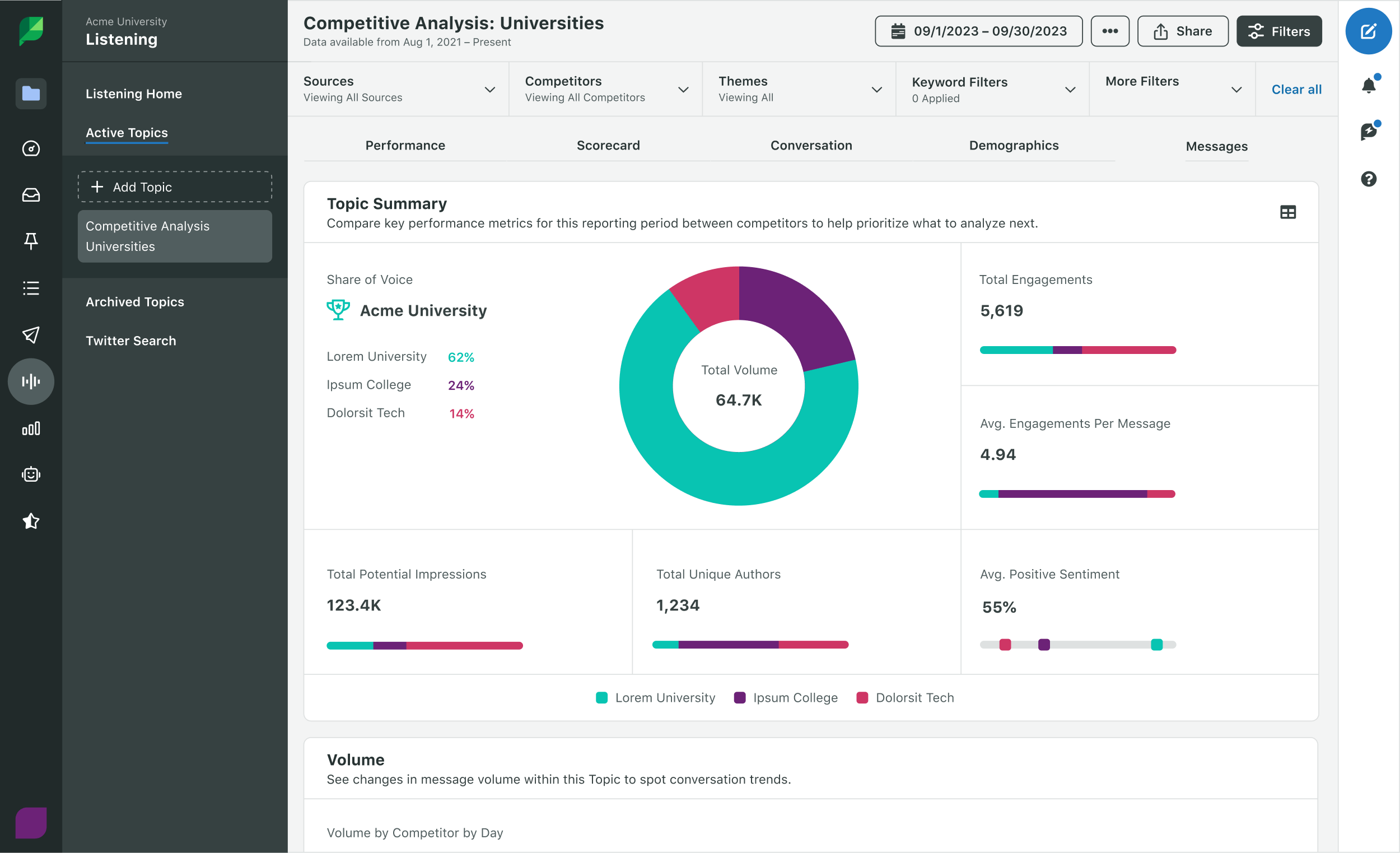
If you use Sprout’s social listening tool, here are just a few of the metrics you can pull to understand how conversations are trending around your brand:
- Total message volume tracks the total amount of messages shared around your brand.
- Sentiment summary measures how people feel about your brand and whether or not it’s trending positively.
- Share of voice compares your brand’s market share on social to its top competitors.
Earned media value
Earned media value (EMV) assigns a dollar value to the exposure a brand receives through unpaid or organic channels. It might be in the form of a news broadcast, a link on a recommendations list or a reddit thread review. Think of it as your digital word of mouth.
By tracking EMV, you can translate your impressions into a monetary figure to see how much that same reach would’ve cost you if you’d achieved it through paid media. You can also see which new channels you’re reaching through this earned media. Both Sprout’s Influencer Marketing and Employee Advocacy tools offer in-built EMV metrics to make tracking its impact easier.
How to increase brand awareness on social media
Social is a go-to channel for raising brand awareness. But how do you become a familiar face within your followers’ feeds versus someone they just scroll past?
If you want to use social media for brand awareness, use these ideas to jumpstart your efforts. From fine-tuning your profile to experimenting with your content, any combination of these tips will help you rise above the noise.
1. Define your brand identity
A strong brand awareness campaign starts with a well-defined brand identity. Focus on what makes your brand or your products distinct, and find a way to channel that into a cohesive message and tone for your social output.
The only limit to this is your own creativity. Here’s an example from the Sour Patch Kids Instagram page, where they often share memes, fake recipes and other content that targets Gen Z and millennials.
Marketers are told time and time again to create “unique” content. It might sound corny, but the person behind your social presence represents a one-of-a-kind voice.
Before you hit post, make a point to ask yourself: “Does this sound like something a bot would say?” If the answer is yes, think of a way you could reframe it to make your post unique or memorable.
If you need more inspiration, check out this article on developing a strong brand identity.
2. Optimize social media profiles and website
Recognition is a key element of building brand awareness. When followers glance at your social profiles, they should be able to understand the basics of your brand, its purpose and its personality.
From social bios to profile images, how you set up your profile determines whether or not people recognize you. Open each of your accounts, and think about what kind of impression it would give someone if they’re accessing it for the first time.
Bios are particularly important across certain platforms. Look at how you can optimize your Instagram bio through a link, refined social copy and your choice of profile image and highlights. TikTok bios require an entirely different approach; due to the platform’s fast-moving nature, bios should be brief, but make sure to link to your website with clear CTAs.
If you’re posting on YouTube, look at how you can optimize your channel by tweaking your thumbnails and video names. This interior design media company relies on its YouTube account to share documentary videos, and has optimized its channel to include an engaging description and several links to the brand’s other social accounts.
Tailor your approach to the unique aspects of each social media platform, and don’t forget to also refine your company website. Today’s attention spans are short, so your website should very clearly communicate your brand and what you represent within seconds.
3. Use a visual content strategy to make your posts pop
A defined visual content strategy leaves a lasting impression. Consistent visuals—like logos, colors, typography and design—make your brand more easily identifiable in a sea of content. This increases the likelihood that consumers will recall your brand when making purchase decisions.
Consider using a familiar colour scheme that matches your logo or products. In the best-case scenario, a clear visual identity can become your brand’s main signifier. A great example of this is the luxury fashion brand Burberry, who are known for their distinct check pattern and colour schemes.
Don’t have eye-popping images featuring your products? No problem. The principle of making your posts stand out rings true in content marketing, too. Notice how Sprout’s blog posts are all coupled with these colorful illustrations instead of generic stock photos?
Anything you can do aesthetically to make your posts stand out is a point in your favor. Even if you’re not a designer, there are plenty of social media post templates to help you whip up some eye-catching imagery.
4. Collaborate with other brands and influencers
When brands collaborate on new releases or campaign ideas, both parties get a chance to introduce themselves to new audiences. Both co-marketing and co-branding campaigns bring engagement from the jump. Not only that, but collaboration is a surefire way to make positive impressions on other players in your industry.
An effective brand awareness collaboration introduces your brand to new potential customers while allowing both partners to benefit from each other’s established reputation.Think about how you can pursue brand collaborations strategically; always start by doing your research on which other companies have a similar audience, values and message to your own. Topical alignment with an influencer matters too–you can no longer just lean on similar audience demographics and expect a message to resonate. You have to prioritize influencers who talk about topics your audience cares about.
Influencer collaborations can be just as powerful as partnering with other brands. The creator economy is thriving. No matter what industry you work in, there’s probably an influencer making waves with your target audience—and those waves have the power to result in serious revenue gains.
Research is still key to success with these campaigns. Make sure to find the right influencer for your brand, and use tools like Sprout Social Influencer Marketing to make managing and tracking your campaigns easier.
5. Engage with your audience
Brand awareness is about more than just creating consistent content; it’s also about regularly engaging with your audience where they are. This might be through responding to comments, handling DMs in your social inbox or reposting UGC content.
Audience engagement shows your followers that your brand is willing to listen and communicate with them directly. This can build trust in your brand, and strengthens your relationship with your followers as individuals.
Just like with content creation, engaging with your audience can be a time-consuming process. Get it right by putting the necessary strategies in place, and set aside some time each day to focus exclusively on your engagement plan. The more questions you’re able to answer and conversations you’re able to join, the more your brand is seen as active and engaged in the noisy world of social platforms.
You can engage with your audience across all platforms. X can be particularly useful for certain companies; here’s an example of the video games company Aggro Crab, who often engage with UGC and other posts to promote awareness of their games.
6. Repurpose content
If you’re like most marketers, you’re probably trying to boost brand awareness across multiple networks. Repurposing content can be a smart way to remain consistent across several different channels.
Remember that it’s important to repurpose your content to fit in with the best practices of each platform. After all, what works best on Instagram might not be prime for Facebook or Twitter.
One-size-fits-all content and captions aren’t going to win your brand much attention. To keep your feed from growing stale, you should always have new social media ideas on the back burner to support speedy content creation.
Create a repurposing strategy to streamline this process. This might include tweaking the captions of an Instagram post so it’s more appropriate for LinkedIn. Or, it might involve cutting a YouTube video into segments so you can post it on TikTok. Think about the similarities certain platforms share, and take advantage of them to save yourself time and get your content in front of more people.
7. Harness the power of hashtags
Every now and then a viral hot take will try to force hashtagging into an early grave. But fret not, the hashtag is alive and well. If you’re choosing relevant, brand-applicable hashtags, they’re a surefire way to increase impressions on your posts.
When choosing which hashtags to include in your posts, consider both the network you’re posting on and the trends driving conversations at the moment. To get a look at hashtag trends thriving across multiple platforms, consider social listening. These tools surface hashtags and keywords that are trending within specific conversations, so you can develop your social copy with intention
Track how well your brand awareness hashtags are performing using hashtag analytics. Monitor certain terms to see which perform well, and learn what type of conversations are happening around your brand. By tracking, you can better understand current audience sentiments, which you can use to refine your brand awareness strategies in the future.
8. Share a distinct POV and brand voice
Brand awareness relies on developing a unique point-of-view (POV) that matches your brand’s identity–your values and what you want to be known for. Your content’s POV should embrace what sets your company apart from others online, and it should be geared by Tone of voice (TOV) guidelines and other internal advice documents.
A strong POV can become a core part of your content strategy, and it means you don’t have to rely so much on jumping on trends. That doesn’t mean you should avoid trends entirely–it just means reacting when the time is right.
Sprout’s 2025 Social Index found that 40% of consumers think trend-jumping is cool, but a further 27% think it’s only effective within the first 48 hours of a trend starting. If you want your brand to be seen engaging with the latest trends, make sure you’re getting content out quickly to avoid being seen as late to the party.
Consider how you can comment on industry trends and happenings from your point of view in a unique or timely way. Keep up with industry publications and research to see where you can insert your brand’s POV.
The takeaway here is that you should contribute to the ongoing conversation of your industry at large versus just sitting on the sidelines.
9. Experiment with your social copy
Whilst a lot of social media is visual, text still plays a huge role in how your brand is perceived. Use your copy to pique people’s interest and encourage engagement, giving a sort of taste to readers before they click through.
Look at how you can use your social copy to reinforce your imagery, or communicate something entirely different. Your copy should speak to your intended audience, using language and references that they’re likely to resonate with. Here’s a good example from WingStop UK, promoting a competition for young people who have just received their exam results.
Don’t count out the power of a well-crafted text post. Once you find your brand voice, it can be a prime opportunity for connecting with followers and letting them know exactly who you are.
10. Show up consistently
Finally, remember that consistency remains a massive part of success on social. Create a social content calendar to make sure you’re posting across all of your accounts regularly, and include some time for engagement within this plan.
The more ground you and your brand can cover, the better. It all comes down to having a specific strategy that makes the most out of the time you spend on social media.
3 examples of building brand awareness
Now that we’ve explored the various paths to building brand awareness, let’s take a look at how some standout brands achieve it. These top-tier examples can serve as inspiration for your own strategy.
1. Greggs and Primark combine brand awareness forces in the UK
Both Greggs and Primark are two of the UK’s biggest brands, but few in the country would’ve expected them to collaborate as a brand awareness play.
This is partly why the Greggs x Primark collaboration campaign has been so successful. Greggs has partnered with Primark multiple times, most notably on a fashion line that recreates Greggs’ iconic colour scheme and logo across Primark’s own-brand clothing.
Greggs has also opened some of their bakeries directly within Primark’s stores at key locations across the country.
Though the campaign relied on physical products in-store, it also involved a substantial digital campaign. Distinct websites were created for both Greggs and Primark to promote the collaboration, and products were shared across all of their accounts on social platforms. This campaign proves how effective collaborations can be, and that being creative and thinking outside of the box can result in significant brand awareness, as long as you understand your audience and their needs.
2. Crunchyroll builds brand awareness where its audience is
Crunchyroll is one of the world’s leading streaming services for anime films and TV shows, which have exploded in popularity across the US and worldwide in the past couple of decades. To promote their service and increase brand awareness, Crunchyroll implemented a significant events marketing campaign to coincide with Anime Expo 2025.
By focusing on Anime Expo attendees, Crunchyroll was able to market directly to people with a proven interest in their service. They hosted several roundtables, screenings and talks at the event, which positioned them as a leading provider and an expert in the space.
They even created a unique piece of memorabilia. They partnered with the Japanese magazine Newtype to create an exclusive magazine, and distributed this to attendees for free. They then promoted the magazine and their events schedule online and across socials, to make sure nobody missed out and to further the reach of their marketing efforts.
Crunchyroll’s campaign shows how important it is for brands to aim for the right kind of awareness. By offering exclusive free gifts to conference attendees, Crunchyroll aimed to create new brand advocates in a space where people were already interested in their platform.
3. Karma Drinks combines physical awareness with digital campaigns
Karma Drinks is a new, ethical soft drinks brand launched in the UK market. The majority of their marketing efforts have been focused on building awareness of their brand whilst showing off what sets it apart from others on the market.
This has included several physical pop-ups at festivals and events across the UK over the summer. But Karma Drinks has combined these efforts with an extensive and ongoing digital content output.
As well as attending BST Hyde Park, they organised a competition on their Instagram to offer followers the chance to win free tickets to the event. To enter the competition, people had to both follow the page, tag a friend and like the post, boosting the reach of the content as well as their main account’s followers.
Karma Drinks proves how important it is for digital marketing efforts to both unite with and support other offline marketing strategies. By creating competitions and content around their event attendance, Karma Drinks is able to boost the value of its on-site marketing, whilst also building an online presence that can help snowball awareness in its brand in the future.
Improve your brand awareness
Building buzz around your brand takes an eye for both experimentation and data. Try new things, report on what works, rinse, repeat.
And when the workload gets too high, try automating some of your routine responsibilities. Sprout’s scheduling and analytics tools can remove bulky, manual processes from your day-to-day so you can focus on creating new brand awareness strategies that gain and retain loyal followers.
Brand Awareness FAQs
What is the main goal of brand awareness?
The main goal of brand awareness is to increase your brand’s visibility across various touchpoints, making it easier for potential customers to recall your brand when they’re ready to make a purchase.
What is the best strategy for brand awareness?
There are many strategies that can support brand awareness, but what matters most of all is consistency. Consistent messaging and visuals across various touch points increases the likelihood that consumers will remember your brand when making purchase decisions.




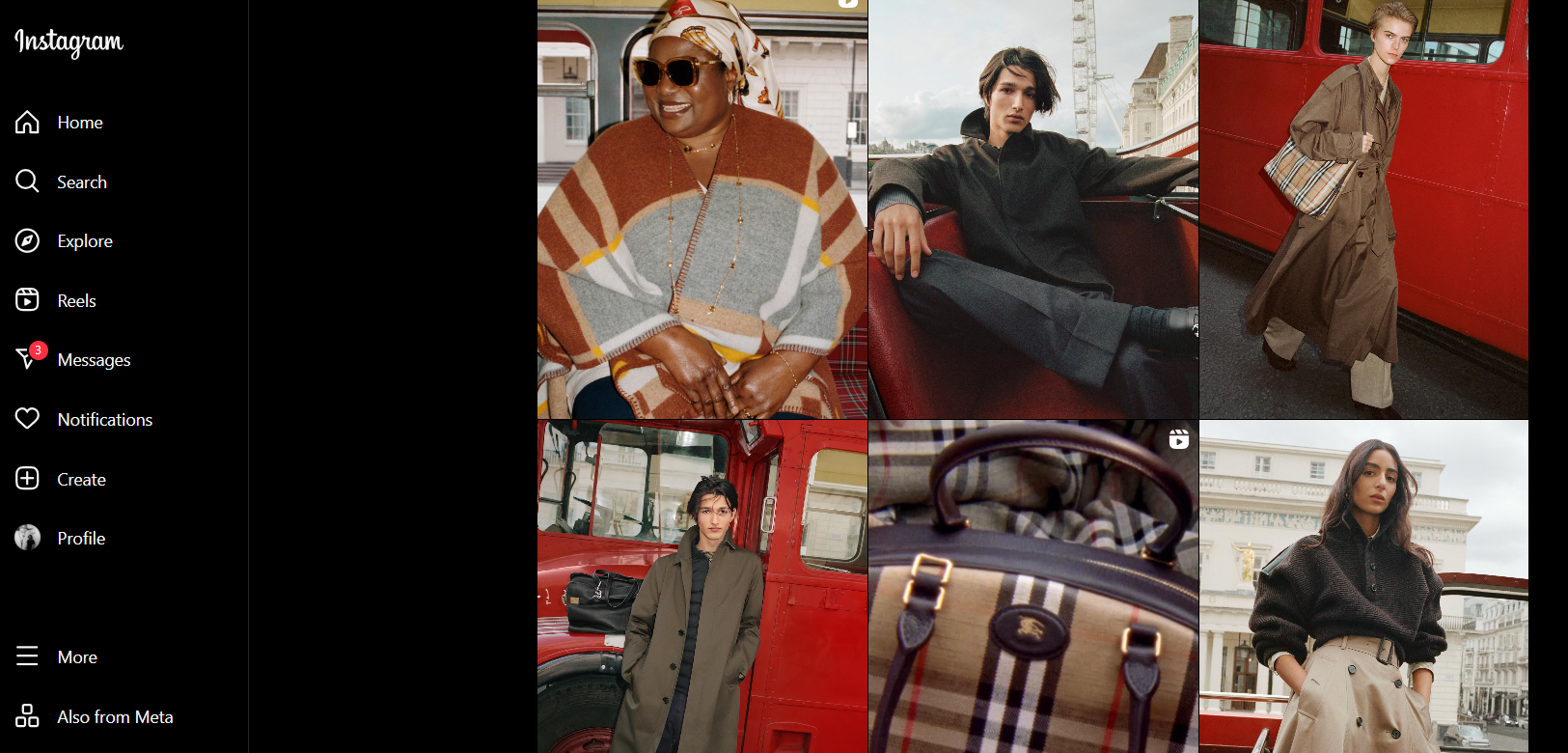
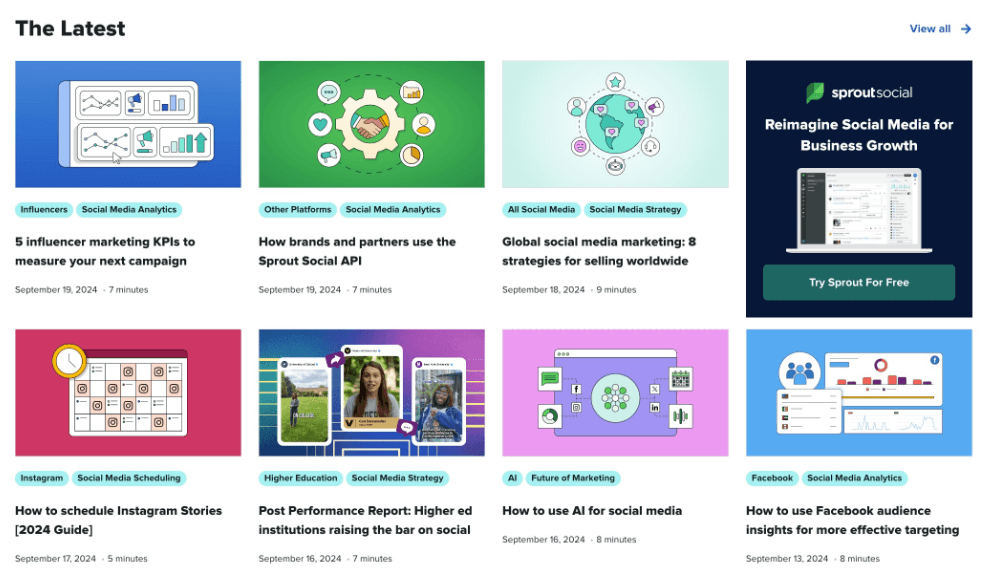



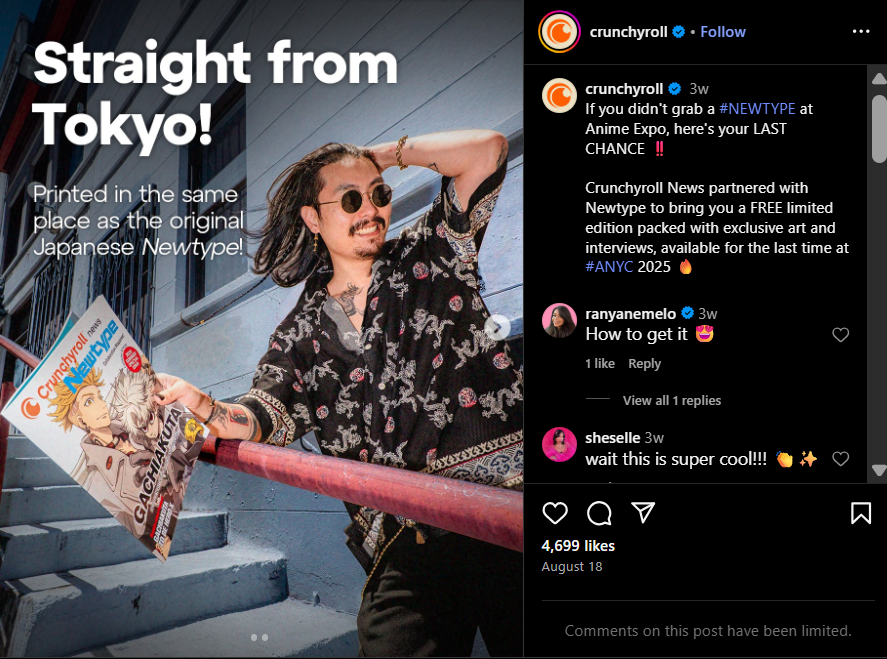


Share